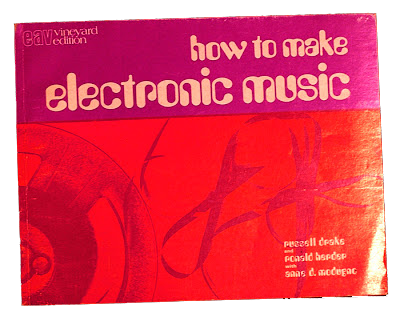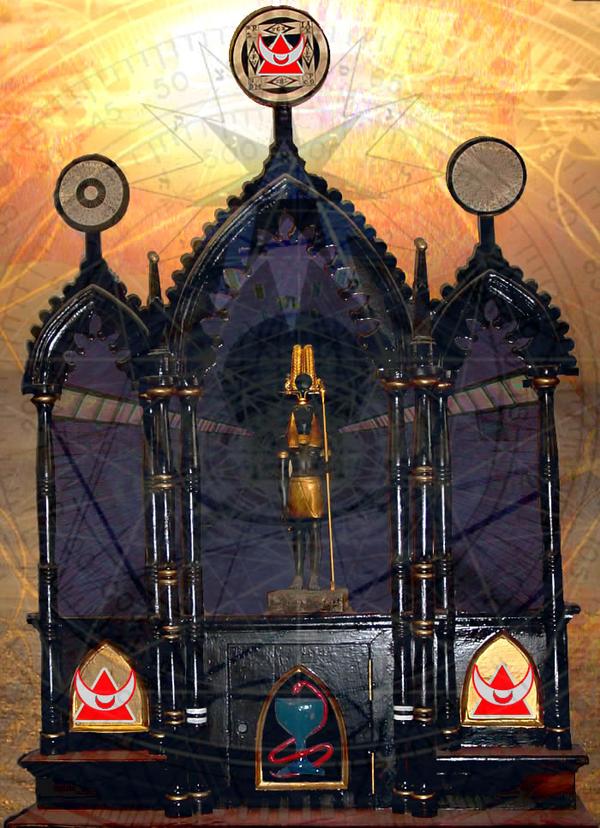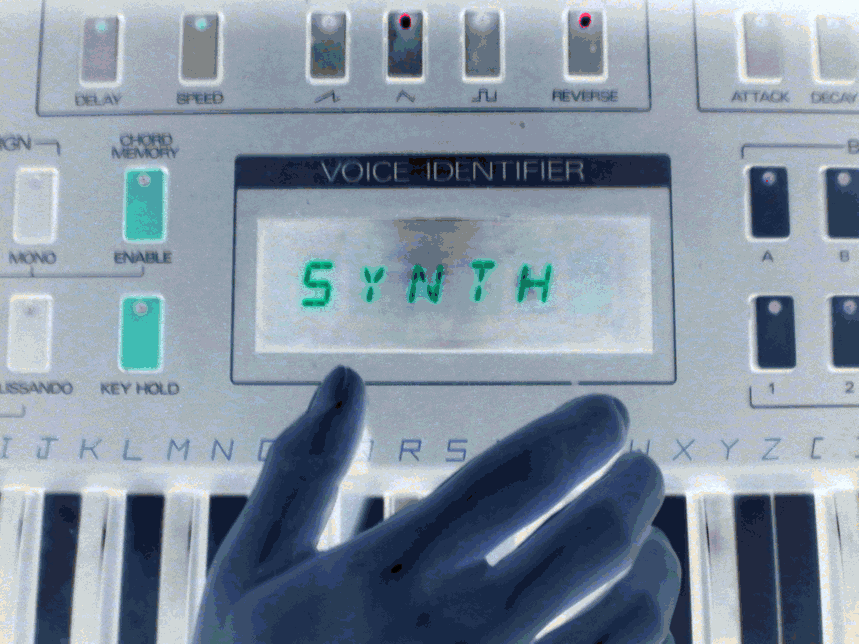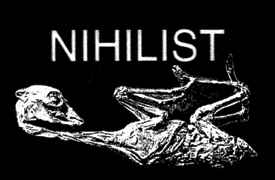“How many times have you wished you could make music? Well now you can! All you need is a tape recorder, some relatively simple skills, some curiousity, and a little imagination. This book has been used in classrooms throughout the country by students, many of them without previous experience in music, who are now composing electronic music projects. In this book you’ll be taken into the exciting world of electronic music and you’ll find the basic tape recorder as well as synthesizer techniques, explained in many step by step instructions, and a variety of experiments to help you make electronic music. You’ll also find a whole set of composing projects where your own creativity can run free and you’ will wonder why you didn’t start sooner.”
The Synthesizer

is a combination of oscillators, filters, ring modulators, etcetera, which are all devices invented that were developed individually over time.
When enough components had been invented for controlling all the elements involved in the creation of sound, they were compiled into a single unit and called a synthesizer.
Even though now the machine has a standardized name, the individual components are still called oscillators, generators, filters, and so forth. They make up the three basic foundational modules of synthesis building blocks:
Sources: produce the raw materials of sound in the form of basic waveforms
Modifiers: modify or alter these waveforms in a variety of ways
Controllers: control or regulate the actions of both sources and modifiers
Voltage Control

In the same way pressure drives a flow of water or steam through pipes an electromotive fore called voltage drives electric current through the circuitry of any device that uses electricity as its power source.
Working with a synthesizer, the composer can regulate a components by hand or they can take advantage of automating voltage control for accomplishing the same task with a higher degree of precision and speed impossible with manual control. For example, you can open or close switches by hand, or turn a volume knob, yet voltages can perform operations at the rate of several hundred or even several thousand times pers second. Because this driving force can be applied in a vast number of ways to affect all of the elements of sound frequency, timbre, amplitude, and duration; the advantes to the composer are enormous.
Some of this choice (manual control versus voltage control) is determined by the peticular components being used, since not all components produce voltage and not all components can be voltage controlled. You must use a control voltage source for regulating a voltage controlled unit.
We will discuss this important interaction in greater detail. To start, however, not the labeling on the synth control panels for three of the most essential voltage controlled modules: VCO, for voltage controlled oscillator; VCF for voltage controlled filter, and VCA, for voltage controlled amplifier.
Sound Sources and Processes
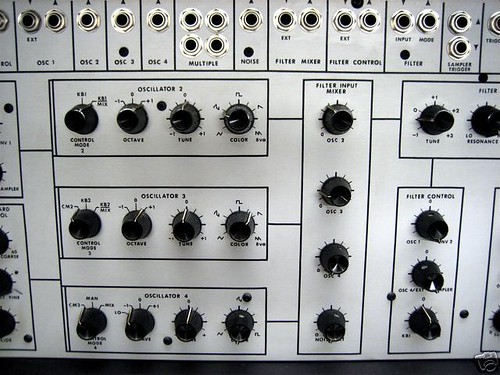
Oscillators
The three main bodies of components used to synthesize sound are typically installed on the control panel for left to right(the same path taken by the audio signal as it moves across the sound production circuits. In order, these are the sound sources, the sound modifiers, and the controllers.
The synthesizers principal sound sources(some of which may also function as voltage controlled sources) are the oscillators. These produce for typical basic waveforms(sine, triangle, sawtooth, and square) with individual timbres, controlling frequencies, and fixed ampolitudes.
The frequency of the selected waveform(which can be regulated by manual or voltage control) can be anywhere in or out of the audible range: from sub audio frequencies below 20 hz to ultrasonic frequencies above 16,000 hz.
Noise Generators

The noise generator produces a mixture, called white noise, resembles the hissingwhen found tuning between radio station frequency bands. (Sound waves producing noise emitting from the very Sun nin our solar system) Since the ear is more sensetive to high frequencies, white noise seems high pitched. Some of the high frequencies can be finltered out to obtain a more audibly balanced mixture called pink noise. Noise is used mainly for creating percussive type effects and to colour other sounds.
Frequency Modulation
Modulation in general is a form of control. In the case of sound sources, modulation is controlling the frequency, either manually or with control voltage from other sources.
For example, the frequency of one oscillator signal can be voltage controlled by the signal of a seconf oscillator. The one being controlled is called the audio signal, or carrier; the signal which does the controlling is called the modulator, or program signal.
In this interaction of two signals, it is the modulator’s waveform that determines the frequency change of the carrier. In fact, you can actually hear the controlling waveform if its frequency is sub audio: Sub audio sine waves produce a frequency change in the carrier that smoothly rises and falls in effect a siren sound.
Sub audio triangular waves produce a frequency change that gradually rises, the immedeately begins a gradual fall. Sub audio rectangular or square waves produce a frequency change that abruptly alternates between two frequencies, with no perceptable sloping. Sub audio sawtooth waves produce a frequency change that gradually rises the abruptly falls.
If, however, you increase the frequency of the modulator into the audio range, you no longer hear its waveform yet now hear an entirely different result: the generation of frequencies in addition to the carrier and modulator frequencies. These additional frequencies, called sidebands, are non harmonic overtones which produce complex new timbres. Besides frequency modulation, there are two other modulation techniques.
Modifiers and Processes
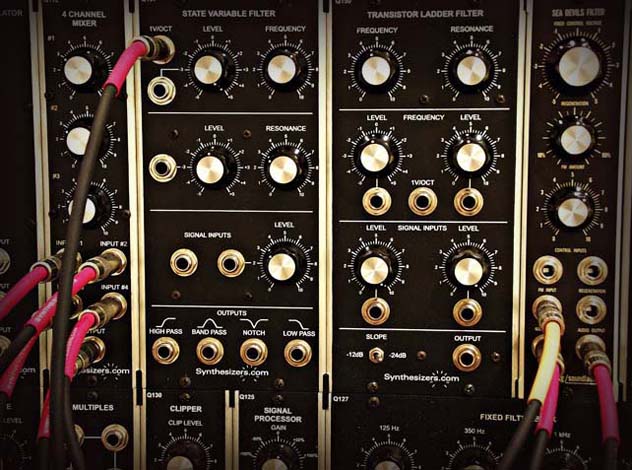
Filters and Subtractive Synthesis
Sound sources can be used alone or in combination , as is or modified in a number of ways. one modification process, called subtractive synthesis, involes use of synthesizer audio filters. Filters are modifiers that change the timbre. they do this by subtacting any part of the frequency range of any sound above or below a variable cutoff point. Depending on the filter, the cutoff point can be manually controlled, or both manually and voltage controlled.
The high pass filter subtracts the frequencies below the cutoff point and passes those abvove. The low pass filter subtracts the frequencies above the cutoff point and passes those below. The band pass filter, with two cutoff points, subtracts both the high and low frequencies and passes the center frequencies. The band reject filter, also with two cutoff points, subtracts or rejects the center frequencies and passes both high and lows. The fixed filter bandk divides the entire audio frequency range into a number of bands which can be subtracted from the whole, either individually or in any combuination . It has manual controls to pass or supress each individual band width. 
Since filtration deals with a variable cutoff point, the composer is working with an adjustment element that can be regulated either by hand or by voltage control. Voltage control has superior advantages of speed and precision in controlling a specific synthesizer module function. This is obvious with the voltage controlled low pass filter. The lowpass filter is the most frequently used in electronic composition because of its usefulness in passing the fundamental and altering the overtones.
If you were to vary the cutoff point by hand, moving it quickly up and down, you would be alternately passing and rejecting a certain band of overtones. This action alternately enriches and dulls the sound without changing the pitch, creating that ever familiar wah-wah sound.
However, you can get the same effect by using a sub audio waveform from an oscillator as control voltage. (Using different forms of control voltage from sources other than an oscillitaor will produce various types of effects.) Besides being a more precise way to control the opening and closing of the filter, voltage control has the other obvious advantage of freeing the composers hands for manipulating other controls manually.
Another feature of the low pass filter is the resonance or regeneration control. This control emphasizes the overtones closest the cutoff point, thus brightening the sound.
Voltage Controlled Amplifier
Using a voltage controlled amplifier VCA, the degree of loudness can be controlled either manually or by control voltage from various sources such as an oscillator, for example. In the same way you can hear the frequency change corresponding to a sub audio waveform, you can now hear the amplitude corresond to a sub audio waveform:
Sub audio sine waves gradually increases then gradually decreases the loudness.
Subtractive audio rectangular or square wave alternates between two degrees of loudness. used in conjunction with manual control, the lower amplitude level can be set, if desired, to preduce zer amplitude(silence). This would have the effect of turning the amplifier on and off.
The rate of speed at which alternation occurs is determined by the frequency of the controlling waveform.
Amplitude Modulation
When you increase the frequency of the modulator into the audio range, you will hear additional frequencies. This modulation technique, called amplitude modulation (AM), produces fewer additional frequencies and consequently, a less complex timbre than the similar technique of frequency modulation (FM).
Controllers
Envelope Generator
Voltage Controlled Amplifier
The most frequent used control voltage source for a VCA and probably the most important to the composer is the envelope generator. The VCA and the envelope generator, working together, shape the sound’s envelope by using the generator’s seperate controls for attack/decay/sustain/release ADSR.
These controls, which determine duration for each enevelope phase, can be set by the composer to produce a phenomenal range of envelope shapes: the envelope of any known sound, custom shapes, even backwards sounds.
As a control voltage source, the envelope generator can be used to control not only the amplitude yet also frequency (via controlling an oscillator) and timbre (controlling the filters).
Keyboard
A synthesizer keyboard is different from a piano or organ keyboard. As a control source, each key when depressed releases a different preset voltage. As in the case of the envelope generator, this voltage can be used to control frequency, timbre, or amplitude, alone or in any combination.
Depending on patching, moving from left to right on the keyboard produces higher pitches, greater brilliance of single pitch, or a progressively louder sound:
The increase in pitch level is a result of frequency control of an oscillator. Increased brilliance is a result of raising a filter’s cutoff point. The louder sound results from control of an amplifier.
One of the most frequently used combinations is simultaneous control, by the same keyboard voltage, of both an oscillator and a filter. This maintains a constant relation between frequency and cutoff point, producing a range of different pitches that have the same timbre.
Using the Keyboard as a Trigger

Another function of the keyboard is the production of voltage to trigger the action of certain components. When the keyboard is used with the envelope generator, for example, this is what happens:
1 Depression of a key triggers the beginning of the evelope cycle. 2 Following attack and decay, the sustain state is maintained as long as the key is held down. 3 Lifting the key triggers the release phase of the envelope.
Keyboard Controls
![]()
The synthesizer keyboard commonly has three controls. used in conjunction with frequency, they function as follows:
Tuning Control regulates pitch over an extremely wide range: tuning to concert pitch, to accompany instruments, or for transposition. Scale Control regulates the intervals between keys: from microtones through conventional half steps to larger intervals. Portimento or glide control regulates varying degrees of glide between pitches.
These controls produce a similar effect on timbre an amplitude. Microtone tuning, for instance, used with an amplifier, can produce cresendos and diminuendos.
Ribbon Controller

The ribbon controller is a metal ribon that produces a varying voltage when you move your finger along its length. The result is similar to the gliding effect produced by the portamento setting of a keyboard, but the more direct means of control enables you to produce minute variations as well as sweeping effects.
Foot Pedal

A foot pedal produces a control voltage which is varied by foot pressure. Although the degree of control is less precise than that provided by a ribbon controller, the foot pedal has the advantage of freeing the composer’s hands for other functions. This is of peticular advantage in live performances where subtlety of control is frequently sacrificed to speed and flexibility.
Sampler or Sample Hold
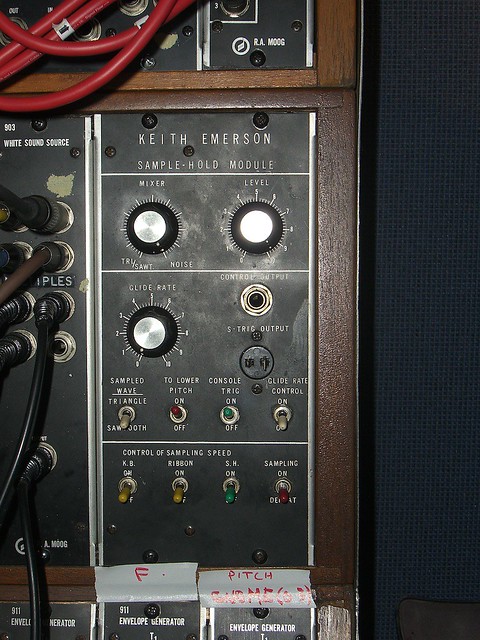
A sampler produces a sequence of control voltages. When it recieves a trigger impulse it samples a voltage level of a waveform and holds the level until it is triggered to make the next sample. The result is a voltage sequence of different levels.
The form of the sequence is determined by the form of the sampled wave. A triangular wave will produce a sequence of increasing and decreasing levels which, if used to control an oscillator, will produce ascending and descending pitch sequences resembling musical scales. A random waveform, like noise, will produce a sequence of random voltage levels.
Sequencer
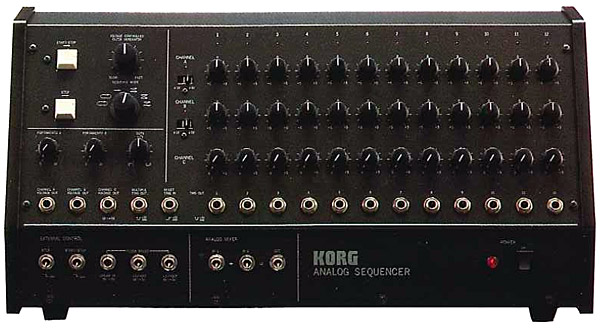
The sequencer is a complex controller which gives the composer precise control over a number of aspects of a sequence of pitches. This is possible because each stage of the sequence produces up to three seperate voltages which can be pre set to control simultaneously the various elements of each sound in the sequence.
For example, one voltage can control frequency; another, amplitude; a third, either timbre or the rhythmic structure of the sequence itself.
Ring Modulator
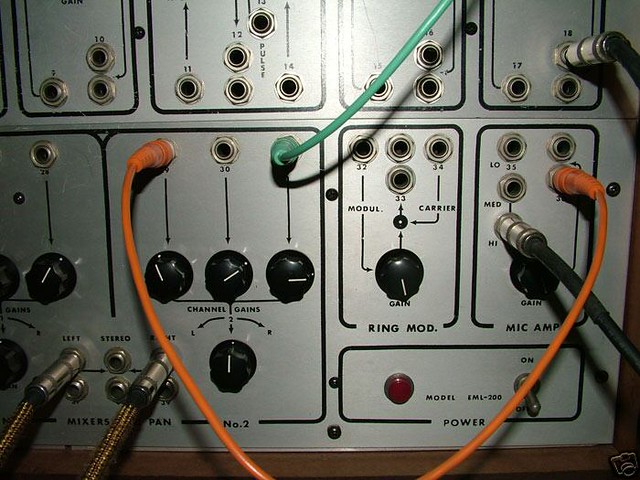
Ring modulation produces an effect closely related to amplitude modulation. Whereas AM produces frequencies in addition to the frequency of the signal being modulated, ring modulation produces the same frequencies but eliminates the original signal. The result is unusual, rather bizarre forbidden planet timbre.
Reverb

The synthesizer’s reverb unit artificially creates degrees of reverberation. Like any other modification techniques, reverb can be applied to signals either produced by the synthesizer or from external sources.
Electronic Switch
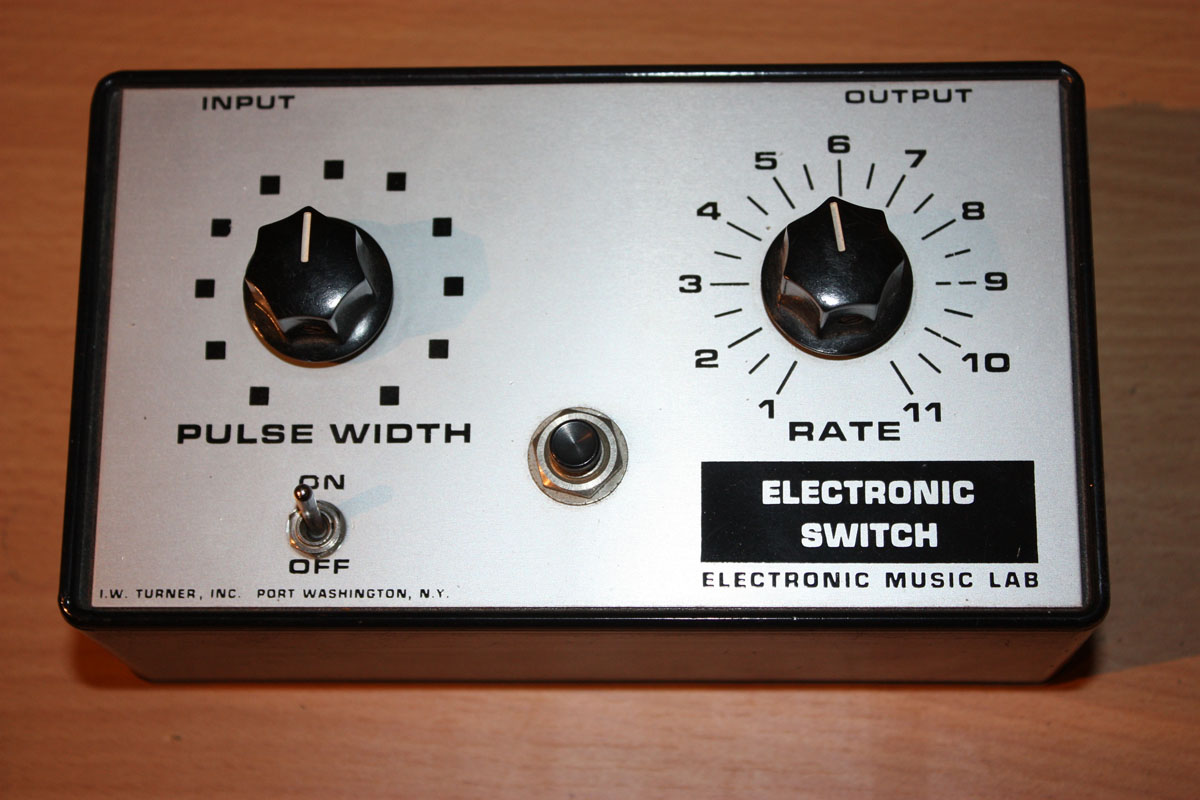
The switch interrupts the flow of a signal by opening and closing the circuit.
Switching a single signal has the effect of chopping holes in the sound by altering sound an silence, breaking continuity or flow. How effectively this alters or masks the sound’s identity depends on the switching speed.
Switching two signals creates an alternating sequence revolving door effect which, if done rapidly enough, modifies the colour of both signals by producing a third composite timbre.
Microphone Pre Amplifier
High level signals from tape recorders, for instance may be routed directly to any components without being pre amplified.
An unlimited array of external sources are available to the composer for synthesizer modification. Any sound that can be taped or picked up by microphone can be modified. Sounds from radio, TV, a record player, as well as any electronic instrument can be fed directly into the synthesizer through external line input, then subsequently modified.
These modifications include filtration, amplitude modulation, ring modulation, switching, reverb, as well as the control of envelope shapes on the external signals.
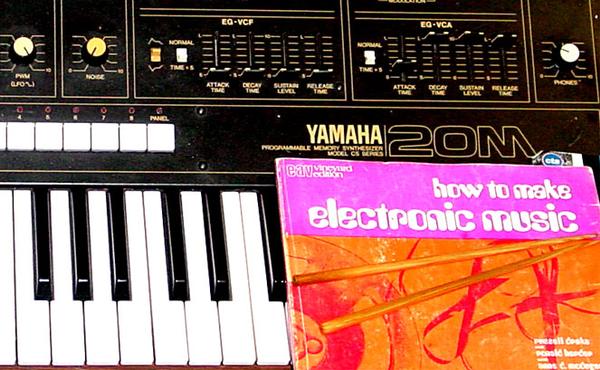 excerpt from How to Make Electronic Music circa 1977
excerpt from How to Make Electronic Music circa 1977
:format(jpeg):mode_rgb():quality(40)/discogs-images/R-6550665-1422143145-3505.jpeg.jpg)
I was given this book years ago plus mysterious 7″ Record titled Synthesis by Herbert A. Deutsch by my old mentor “Thee Master OV Metaphysiques” Ammon De Adda; thus exceptionally influencing my path since that “Magick” time.
Introduction to Musique Concrète
During World War Two the first tape recorder was used by the Nazi propaganda machine to broadcast material edited using a dextrous razor blade. The arrival of these machines into the rest of Europe after the war came as quite a shock and persuaded Britain to develop their own machines based on the German design. Although initially developed for the BBC, it was the enthusiastic amateur and experimenter who often saw the real potential for tape recorders as a tool to creatively change the nature of recorded sound.
One source of this creativity came from French composer Pierre Schaeffer, with the help of RTF (Radiodiffusion-Télévision Française), who gave Schaeffer and his colleagues an opportunity to experiment with recording technology and later on, tape manipulation. His new techniques soon became known as Musique Concrète among artistic circles.
The idea behind Musique Concrète is that the composer begins with a set of “concrete” sounds and arranges them into a piece of music. This concept means that the composer is not limited by traditional musical instrumentation and theory. They can, in fact, collect any sound that appeals to them and use it in the realisation of a final piece of music.
Étude aux chemins de fer, by Pierre Schaeffer, is widely recognised as the first piece of Musique Concrète, and it was Schaeffer’s work, in particular, which pioneered in defining the style.
Musique Concrète can often be misunderstood as simply referring to music made entirely of naturally occurring sounds, and not containing instrumental and human input. While this plays a major factor in Schaefer’s early development of the style, it should generally be viewed in a slightly broader sense than this. In reality, and more accurately, the style embraces new sensibilities of musical expression and restructures the framework of everyday sounds in a way that does not rely on the traditional use of musical characteristics.
Before the age of recorded sound, composition meant the reproduction of written musical notation. In particular, a specific array of timbres such as instruments, for example, were assumed, as well as a particular tonal system. On the other hand, Musique Concrète breaks down the structured production of traditional instruments at their roots in an attempt to compose and structure music from the bottom up.
Technology and Development of Musique Concrète
In 1948, the typical radio studio consisted of a series of shellac record players, a shellac record recorder, a mixing desk with rotating potentiometers, a mechanical reverberation, filters, and microphones for recording. These machines offered Schaeffer and his colleagues a limited amount of creative options in which to define the characteristics of early Musique Concrète. Schaeffer began by using these early technologies to compose music consisting of a series of successive sound extracts. Schaeffer found that the issue with this method was that the composition drew particular attention to repetitive and overly familiar characteristics of the sounds. Schaeffer later concluded that using sounds that retained a significant proportion of their tonal characteristics had created the problems of association. He attempted to overcome this by experimenting with the effect of playing recordings at different speeds.
After his first piece of music (Étude aux chemins de fer) Schaeffer composed a series of short Etudes, which would see him re-assess the role of natural instruments, study their characteristics, and apply appropriate electronic procedures such as reversing or playing sounds at different speeds to create new music. This time, Schaeffer found that his early transformation techniques still failed to alter the complex characteristics of sound sources, and concluded that they failed to produce anything new. Therefore, he began to examine sounds on a more micro level in an attempt to expand the range of transformation techniques. He examined the details of their characteristics such as attack, timbre, and the body of a note, for example. He found it was possible to remove the familiarity of musical instruments by techniques such as removing the attack of the recorded sound. For example, Schaeffer discovered that if a record malfunctions and causes a loop within the sustained resonance of a sound and not during the attack, it could change the musical characteristics of the sound entirely. Schaeffer would then go on to develop and experiment with these principles in his piece, Symphonie Pour Un Homme Seul, which made heavy use of record loop manipulation.
In 1951, the RTF provided Schaeffer with a new purpose-built studio, which saw the introduction of the tape recorder and opened up a wide range of possibilities. The tape machine made the manipulation of media, and procedures such as speed variation and looping much easier than previously possible. A completely new compositional procedure was born. Small bits of tape could be edited together, creating whole new sounds and structures. From here on technological advancements in tape machines and synthesis continued to extend the sound manipulation techniques available.
Legacy and Influence
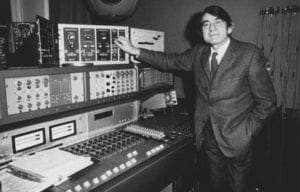 Many people would argue that Musique Concrète is simply a collection of meaningless processed noises with no real musical substance. But it could also be argued that Schaeffer was simply using the best tools available to him at the time in an attempt to create something genuinely new and exciting. It could be easy to pass his compositions off as meaningless, but it should be noted that early Musique Concrète was fundamental in the development and influence of future musical genres. The following are some case examples of genres and tracks with clear Musique Concrète influences:
Many people would argue that Musique Concrète is simply a collection of meaningless processed noises with no real musical substance. But it could also be argued that Schaeffer was simply using the best tools available to him at the time in an attempt to create something genuinely new and exciting. It could be easy to pass his compositions off as meaningless, but it should be noted that early Musique Concrète was fundamental in the development and influence of future musical genres. The following are some case examples of genres and tracks with clear Musique Concrète influences:
Psychedelic & Progressive Rock
Although predominately guitar based, these genres often took influence from the tape manipulation effects of high art genres like Musique Concrète. Some examples include:
The Beatles – Tomorrow Never Knows – Perhaps one of the most important tracks, in terms of introducing Musique Concrète techniques into popular music. Experimental tape loops and studio effects would become ever more popular and eventually become common in the 1970’s with progressive rock artists.
The Beatles – Revolution 9 – A track that was intentionally influenced by concrète techniques such as tape looping and manipulated sounds. In fact, John Lennon is said to have had regular contact with Karlheinz Stockhausen – an early electronic composer – who has worked with Musique Concrète including some work within Pierre Schaeffer’s 1950’s studio.
Pink Floyd – Money: It’s hard to Imagine Pink Floyd creating the tape loops heard at the being of this track, without the pioneering efforts of Pierre Schaeffer and of course the introduction of such techniques into popular music by the Beatles before them.
Industrial
Industrial music was a style that aimed to create music in the context of late industrial society and increasing alienation from nature. Artists would utilise industrial noises as a rhythmic backbone made from tape loops and later on, samplers. Some examples include:
Throbbing Gristle – Discipline
Laibach – Vier Personen
Collage/Plunderphonics
Born directly out of Musique Concrète, collage music is a highly controversial genre of electronic music that involves unashamedly sampling other people’s music or media to create new tracks. Some examples include:
The Evolution of Control Committee – Rocked By Rape
The Justified Ancients of Mu Mu – Whitney Joins the Jams
John Oswald – Dab
Changing The Musical Landscape
So far, we have established that many people would view Musique Concrète as artistic fluff with no content. But we have also established that many essential 20th-century artists have been directly influenced as a result of the pioneering efforts before them. So arguably, Musique Concrète should be credited as essential groundwork for much of the music we listen to today. It was because of pioneers like Schaeffer and Pierre Henry that people began to question traditional musical sensibilities and explore a broader range of techniques in search of something original. They were daring to use sources that had until that point, not been viewed as musical at all, and in the words of Schaeffer himself:
“Noises have generally been thought of as indistinct, but this is not true.”
Had the people involved in musique concrete not dared to be different, the musical landscape of the 20th century might have been quite different indeed. The Beatles may never have moved beyond 60’s 3-minute pop songs, progressive rock might not have happened. And, in a more modern context, the sampling and scratching techniques of rap and hip-hop might never have taken off. Throughout the 20th century and beyond, our perception of what music is has changed dramatically. The beginnings of this change – and indeed electronic music as a genre – can arguably be traced back to Musique Concrète. Therefore, in the eyes of many, Musique Concrète pioneered a sonic revolution that changed our perception of musicality & production forever.
Conclusion
We have managed to establish some of Musique Concrète’s influence on popular music, but there remains a distinct barrier and contrast between the two, which leaves one to ask: what is the difference between high art genres and popular music. But more importantly, where and how have the two managed to meet in genres such as Progressive Rock and Industrial?
Chiefly, the difference can often be put down to the context in which the musical content is presented to the listener. For example: take the noisy samples of industrial music, which on their own just sound like the early stages of a Musique Concrète piece. However, load these sounds into a sampler, give them rhythm, and you have something of superior commercial merit.
Consequently, we have a musical style that is viewed in very close relation to Musique Concrète but is perceived by listeners to be of greater commercial value. Thus, we can see that by simply giving noises structure and rhythm, we can transform high art foundations into something more digestible. In essence, this is exactly what groups like Pink Floyd and The Beatles were doing: Taking Concrète techniques and applying them to a commercial formula.
 So on one hand we can see how Musique Concrète was – in the scheme of things – simply experimentation. But on the other hand you don’t have to go much further before you end up with something of real musical and social importance. Making Musique Concrète, very historically important indeed.
So on one hand we can see how Musique Concrète was – in the scheme of things – simply experimentation. But on the other hand you don’t have to go much further before you end up with something of real musical and social importance. Making Musique Concrète, very historically important indeed.
Alternatively, to read more about Musique Concrète from the pioneering man himself, pick up a copy of Pierre Schaeffer’s In Search of a Concrete Music (À la recherche d’une musique concrète), which has recently been transcribed into English.
Gnostic Pythagorean Musical Theory
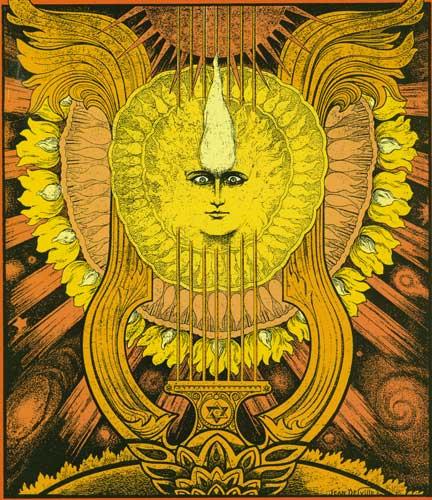 Welcome to the Wednesday Night Experimental Music Programs at the SPACE CAFE PERFORMANCE HOUSE. Tonight we are beginning a new series of performances which will occasionally begin with preliminary talks on the various aspects of our current work. The concerts are sponsored by the GIORDANISTI PRESS and EIDOLON TAPES and represent the continuing work of the EMERGENCY THEATER founded at Chicago in l980. That group of artists stated in their first manifesto their intention to make experiments on the “magical imagination” taking a term from one of the illustrious personages in their lineage: Giordano Bruno. Through ceremonial invocations of a discontinuity of atavistic imagery and pheumatic music their purpose was the transmission and reception of certain occult formulae which would deepen and intensify introverted reality. Our work tonight continues the investigation of what has become known as Gnostic Acoustics. By way of introduction and perhaps to suggest what the forgoing sounds may enliven in your thoughts, let me offer a very general plan for ideas to rise in the form of historical documents. According to ancient cosmogonies the world was created from an acoustical substance, an initial sound which became light. Eventually part of this light became matter. This materialization however was never completed because each material element still retained some of the sonorous substance out of which it was created. This implies some hidden influence which is affecting us today, moment to moment.
Welcome to the Wednesday Night Experimental Music Programs at the SPACE CAFE PERFORMANCE HOUSE. Tonight we are beginning a new series of performances which will occasionally begin with preliminary talks on the various aspects of our current work. The concerts are sponsored by the GIORDANISTI PRESS and EIDOLON TAPES and represent the continuing work of the EMERGENCY THEATER founded at Chicago in l980. That group of artists stated in their first manifesto their intention to make experiments on the “magical imagination” taking a term from one of the illustrious personages in their lineage: Giordano Bruno. Through ceremonial invocations of a discontinuity of atavistic imagery and pheumatic music their purpose was the transmission and reception of certain occult formulae which would deepen and intensify introverted reality. Our work tonight continues the investigation of what has become known as Gnostic Acoustics. By way of introduction and perhaps to suggest what the forgoing sounds may enliven in your thoughts, let me offer a very general plan for ideas to rise in the form of historical documents. According to ancient cosmogonies the world was created from an acoustical substance, an initial sound which became light. Eventually part of this light became matter. This materialization however was never completed because each material element still retained some of the sonorous substance out of which it was created. This implies some hidden influence which is affecting us today, moment to moment.
The Pythagorean idea of a Music Of The Spheres implies a similar influence. They theorized that as the planets of differing size, distance and activity push their way through etheric space they force subtle modulations and vibrations to penetrate throughout our Solar System. To the Ancients the sacred planetary number was seven, however as this philosophy evolved more were added including invisible ones until all puncitiform space was filled with metaphysical planets. The same fate was met by black holes in our own time by the Diabolicals.
Pythagoras reasoned that if sound exists as a natural element in the universe, the movement of the celestial bodies can be expressed as mathematical ratios in resonating bodies on Earth. The early partials of the overtone series arising from that resonating body eventually became our musical scales. Since music and consciousness depend upon the same principles of frequency, these ideas have increased to become a conceptual web for musicians and philosophers alike. The search still goes on well over a thousand years later to correlate sounds with corresponding things whether they be colors, gem stones, planets or chakras. However in the meantime people were listening to other forms of artistic invention. Thirty thousand Greeks were capable of following performances of the tragedies of Aeschyus with unflagging interest because of an alliance of all the arts uniting in a common object. Centuries later melodic phrases, leading motives and their thematic transformations referring to persons, things, sentiments or events quickened the attention of several hundred listeners to Wagners Operas.
The Music Of The Spheres idea went underground surfacing now and then in Gnostic Chant or Renaissance architecture. The “sacred sound” found in nature became systematized, first by Priest craft then by secularist tradition both overwhelmed by the first few partials- shutting out the higher and less audible ones. There could as easily be a case made for corresponding the higher partials of the harmonic scale with those heretical sects that were abhorred and equally banished: the Gnostics, the Templers and Alchemists, all thought of as being ‘dissonant’ to civilized progress. The association of good and evil put upon certain intervals by renowned composers like Stravinsky, or the lecturing of Leonard Bernstein on the subject of the first half of the 20th Century as being an “unhealthy” period for Mother Earthís tonal goodness, is only a continuation of an older fear of the dissonant. Remember the earlier stigma put upon the eleventh partial as the “Devils Triad”? Considering that the tri-tone (dim.5th/aug. 4th) is the glue that hangs together equal tempered harmony (making modulation possible), could Western classical music be a vast Satanic conspiracy? There are those who would argue that the tonic-dominant resolution is indeed an evil symmetry. This fear is not innate however, and is only built upon a few hundred years of musical habit directed by composers and specialists in their search for the elusive Goddess of Beauty. Perhaps an artist is like a fowler, he or she does not produce beauty but knows how to capture it. Here lies the aesthetic dichotomy- it is a matter of knowing whether Pythagorean ratios constitute beauty, or whether they are only a preparation for it- whether the rational organization or the spiritual charm inherent in the sensible is art. I tend to feel that a conscious embrace of Pythagorean spheres or “world music” results as Morton Feldman noted “When musicis universal it never gets beyond its freshman level.” (Arnold Schoenberg had said basically the same thing: “If it is art it is not for all and if it is for all it is not art”),Yet the temptation to tie into some cosmic scheme or claim angelic or demonic overshadowing at the site of your improvisations looms ever strong. Gnostic Acoustics merely wishes to map the range and reach of the “aesthetic arrest” (Joseph Campbell’s term), where one may enjoy as listener or player conceptualization, as well as experience where all contrived meaning has ceased. Sometimes it ís hard to tell the difference- or maybe the latter is impossible.
ADDENDUM
Following the holographic model of Pythagoras, who many site as the Father of our Western esoteric tradition, what we find in the harmonic series are serial modifications of a primal energy. Taking “Middle C” as a fundamental tonic or root monad (Kether in Atzilut), we travel four octaves away through the four Kabbalistic worlds and arrive at the eleventh overtone (the “Diabolus in Musica”) said to be the most dangerous interval. This is, according to Lurianic speculation situated in ëthe world of shells (olam h-klipot) the farthest reaches of cosmic catastrophy (shevirat h-kelim) or the “breaking of the vessels.” It was after this shattering or “fall” that all phenomena began and the “nations of the world” were produced from its cortices. Practitioners of the Thelemic Religion assign the number eleven to their “new aeon magick,” the “once beyond ten”, because it is situated at the core of what most needs redeeming. Dane Rudhyar indicated that the eleventh partial represented the key-note of the Atlantean Race and its ultimate fall into black magic adding that the element of occult-fire is the basis of “true magical operations.” (Liberation Through Sound, A Course in 10 Lessons , Dane Rudhyar,Brookline, Mass. Hamsa Publications, Mimeograph.)What Rudhyar’s insight was trying to shape (following Blavatsky) is nothing less than the panorama of history through the symbolism of harmonic overtones. He portrays our species as evolving millions of years through a series of drifting root races with certain tones signaling evolutionary epochs. (Fig.2) He calls the relationship between the tritone E and B flat (5th and 7th harmonics), “the revelation” for its “inner workings” and perhaps because it pulls out of existence the dominating power of the tonic from its home world. Considering the enigma that the eleventh overtone has with the tonic, the 11:7 ratio tells us in kabbalistic terms the vanishing nexus that could result if the holographic model is fully reified to collapse in a state of non-being. AIN 711.
During a sitting with the Chicago trance-medium Princess Andraes in the early Sixties there was an interlude of unexpected synesthesia. When notes accidently sounded on a piano in the room, she spontaneously responded with an intersense analogy– gustiferous in nature. Quietly moving to the keyboard hoping not to break her trance, I began an impromptu research in the analysis of intervals all of which resulted in some fairly precise information which convinced me she was actually tasting each interval. Thirds and sixes transformed into various modifications of sweetness. The Perfect fifth was neutral, almost tastless, a minor seventh had a “dissolving bitterness.” Then too quickly perhaps I sounded an augmented fourth (11th partial); first she looked totally bewildered then recoiling in a choking manner grabbed her throat and exclaimed she was being poisoned.
Research and experimental procedures could go on indefinitely and not bring any kind of spiritual conversion. What is all this heaping of esoterica in correspondence for? What is it a sign of? If it is to build lists of similes and catalogues, or give metaphor for poetry then the most powerful magic is lost and Pythagoreanism is indeed dead in our time. The essential identity through the introspective experiment that the Pythagoreans of the 5th century B.C. and the Neo-Platonists after them made, is a recurrent pattern-intuition of a field-type reality. (Reality and Empathy, Physics, Mind and Science in the 21st Centrry, Alex Comfort, Albany N.Y. SUNY Press 1984 p.30). They completely identified mathematics, music and philosophy. This constituted their state of knowing (gnosis). If an idea is eternal than all expressions of it are essentially the same. “A piper and the cosmos might sound the same note.” (The Music Of The Spheres, Jamie James, New York Grove Press, 1913). The identity of the Greek soul with this scheme was clear and solid. The Modern Gnostic revisionist can still make the introspective experiment but the “same note” can reveal other data. In a few hundred years, as James points out , the soul identity became increasingly unclear. In the age of Freud and William James music and mathamatics had no more inherent meaning than “smelling a rose or cutting one’s finger,” (ibid p 211), and an influential composer like John Cage could teach “to more and morecompletely liberate sounds from abstract ideas about them andmore and more exactly to let them be physically uniquely themselves” (A Year From Monday (Juilliard Lecture, John Cage, Middletown Conn. Wesleyan 1967, p 100), But I ask you-what is this a sign of? Isn’t it a heaping on of another kind of exoterica? The first extreme is Wagner’s wanting everyone to get the same message (German obedience), the second is total lack of a common denominator among diverse sounds of Cage’s post-metaphysical world. The latter is perhaps more in line with the latest physics hypotheses however unstable, of what “themselves” might be. But then theres the point of getting a better view of the attributes of diverse things not only independent of a particular vantage point but to determine their final nature. No matter how much Cage took appart things in order to let them “be”, they still cannot escape their antecedent contingence. This nit-picking does not detract from his genious or the idea of “music of chance”, on the contrary Cage has set the stage for a yogic analysis of momentariness.(An objects quality of disintagrating moment by moment is its subtle impermanence. Appearance & Reality, Guy Newland,Snow Lion Publications p 30).
When the Gnostic Revisionest implements the unresolved tri-tone drone, the very scales of impurity in the depths of the universe may peal off to reveal the so-called “cosmos” as really a cosmetic-job, a cover up. [In Gershom Scholem’s seventh lecture on MajorTrends of Jewish Mysticism, New York Schoken Books 1961, he speaks of the deepest roots of the klipot existing already before the shattering of the vessels, these being mixed up with the sfirotic lights (residue of Ain-Sof in primordial space). One may ask, when was their ever “cosmic order”?] What suddenly rouses to reality is a reeling blood-drenched gnashing Chaos, out of control and ready to burn us up. Rudhyar in his lessons on sound, states that the harmonic eleven is the “pulsatingheart“, quoting Blavatsky, the “bundle of electro-magnetic forces of maya,” meaning the illusion that phenomenon has true existence. The Gnostic will realize this assessment includes the whole harmonic scheme, where even the “sweetness” of a universal Father-tone eventually putrefies, and like the depleted billows of a cosmic organ exhausts itself as the impetus of his karma fades.
This interval in the possession of a skilled Alchemist can be the basis of the current Hermetic Opus, in that it expresses an inscrutable tension, having qualities of non-duality with an androgynous fever, as the axiom of the Alchemical Dragon goes: “the exact poison to cure poisoning”. Remembering that C-F sharp is in the middle of our tempered scale, dividing the octave exactly in half, unreconciled opposites within the Desire Realm may be solved by a “Centrist” philosophy that avoids resolution into the stifling requirements of an eternalism and the dispiriting nihilism of mechanistic reductionism. See The Central Philosophy of Tibet, Robert Thurman, Princeton University 1984, p 24
ADDENDUM II (Figure 2 )
The Gnostics of the early centuries turned the Tree of Life (Religion) on its head- actually back on its feet.Their most excellent way to connect with a spiritual path, that put the demands of the relative into the context of transcendence, was to adopt the ascending order of the sfirot, starting from the bottom and rising, through the development of the individual in an evolutionary advancement. [Gikatilla and Abulafia, eminent kabbalists of the 13th Century also adopted the ascending order (for still disputed reasons) as did Alchemists who depicted the Tree of Life growing out of ones heart.] The Gnostics could not be fulfilled by mere obedience to the laws of a static, (therefore paradoxical) identity at the top of the Tree of Life. What was both eternal and emanational presented a dichotomy to them and not a refuge. This logic and reasoned insight set their Religion apart from the accepted belief, and is heretical today as it was then in the Judean-Christian world. Through pathways of the mind a more powerful support for them, and indespensable for purified growth was through the laws of karmic evolution, where honoring the innuendos of spiritual action lead to their further effects toward freedom. This was not at all an unrealistic idealism with intangible benefits. Keeping ones beginningless karmic continuum in mind, notice that the harmonic process does not stop at the eleventh partial but goes on to infinity. One might ask where does this ever swarming panchromatic music play itself out – if not in our billion-celled neurological orchestra? Stop for a moment and listen to that hiss inside your head. Here is the infinity of the upper partials and their spawn – the impending down-pour for all sentient life. Can there be any more condensed musical prophecy than this? What better army of tantric allies can one have to vaporize the ego perspective, as we translate this space into number and deconstruct the whole of it?
1st Octave: (one interval) Sound of the “luminous Nous” The Great Breath as unitive state and cosmic measure of the future universe.
2nd Octave: (two intervals) The Chord of the Augoedies “the Deamon” in Throne Room of the Higher Mind. The Noumenal as creative “Archetypal Man”
3rd Octave (four intervals) Chord of the “Magical Link” and votary world. Dom. seveth and the ensuing Hermetic/musical “doctrine of signatures”
4th Octave (eight intervals+) The Chord of Yeldaboath “exiled” by egoic perspectives. The incarnation of Cthonic dissonance and mundane sensorial reaction with the ensuing state of amnesia (prison world).
Synthesis (SYNTH) (from the ancient Greek “with” and “placing”) refers to a combination of two or more entities that together form something new; alternately, it refers to the creating of something by artificial means. The corresponding verb, to synthesize (or synthesise), means to make or form a synthesis.
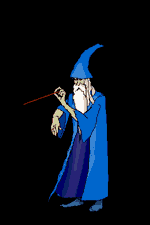
Wizard (WYZRD) n 1. a person who practises or professes to practise magic or sorcery 2. a person who is outstandingly clever in some specified field; expert 3. a wise man 4. computing a computer program that guides a user through a complex task adj 5. informal chiefly superb; outstanding 6. of or relating to a wizard or wizardry [ variant of wissard, from wise 1 + -ard ] ‘wizardly adj wizard c.1440, “philosopher, sage,” from M.E. wys “wise” (see wise (adj.)) ard. zynyste “magic,” zynys “sorcerer,” zyne “witch,” all from zinoti “to know.” The ground sense is perhaps “to know the future.” “wise magical power!”

